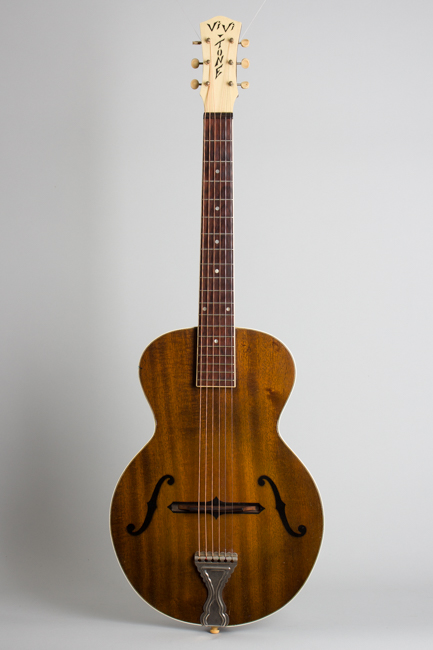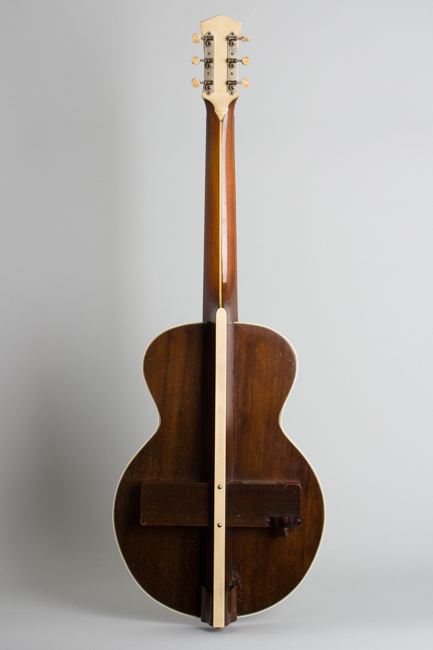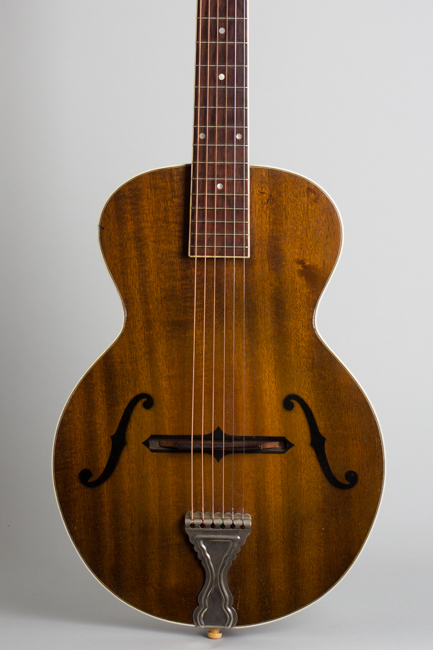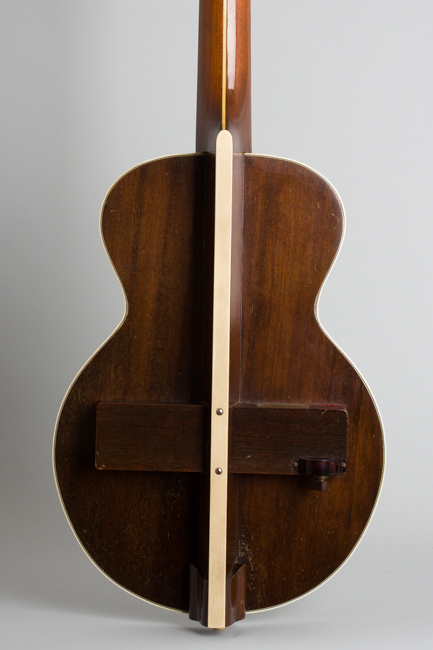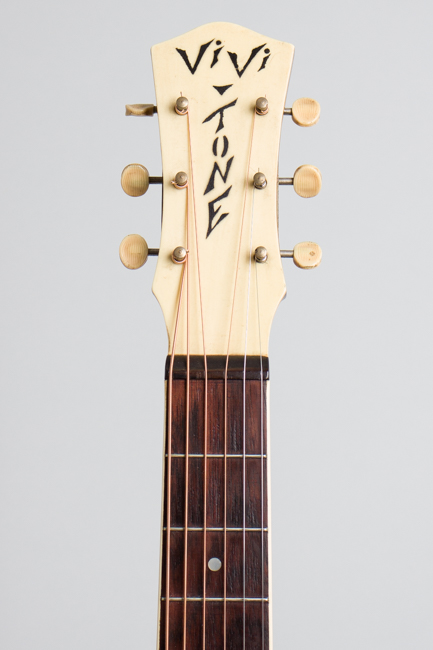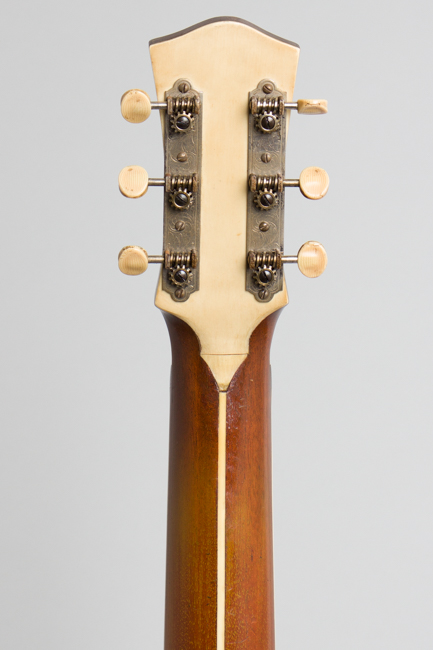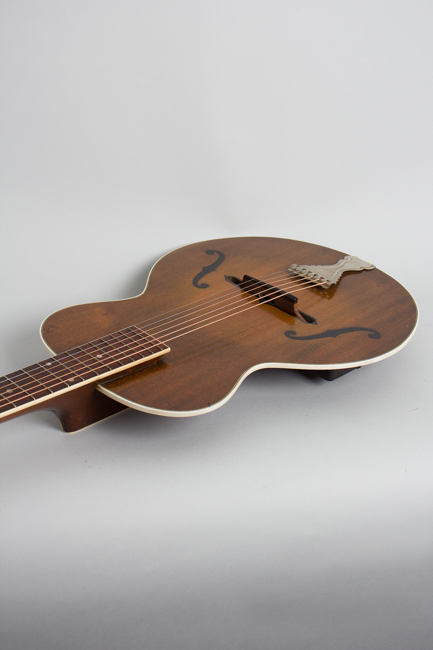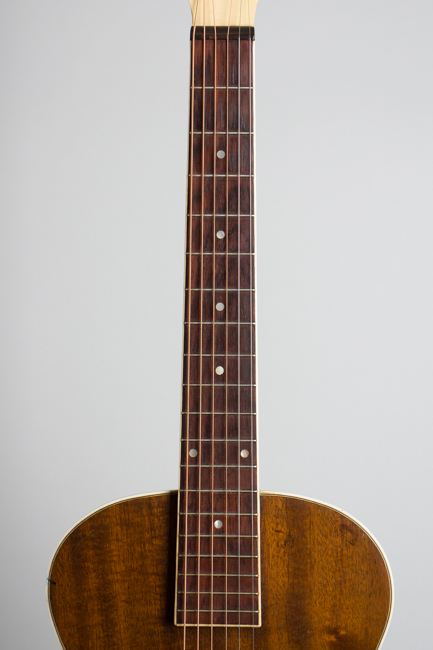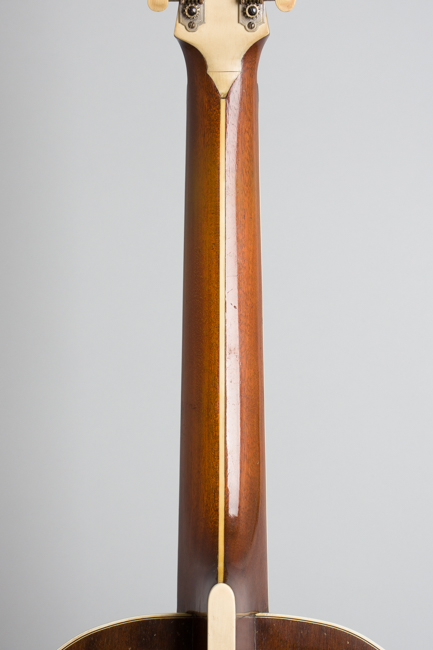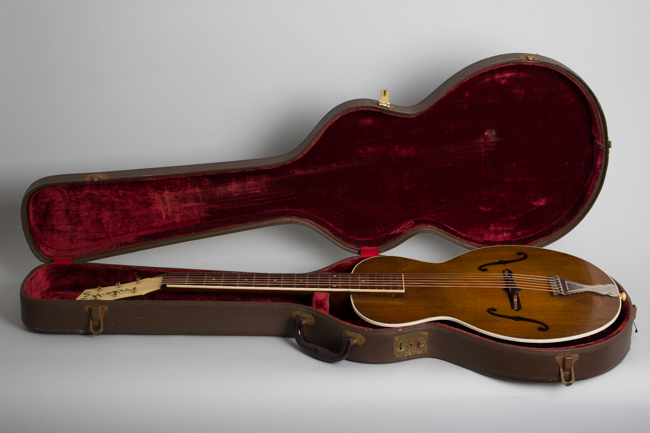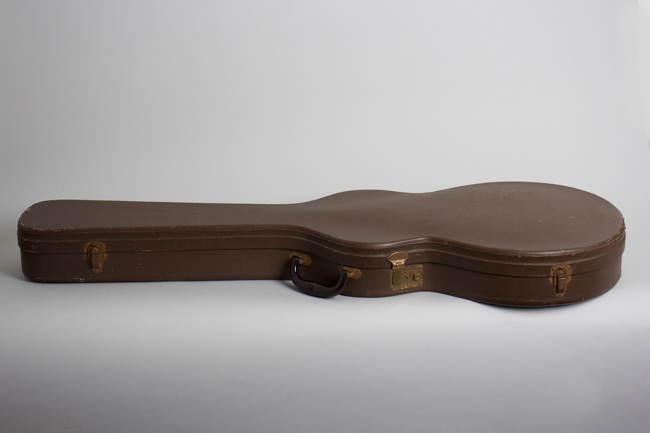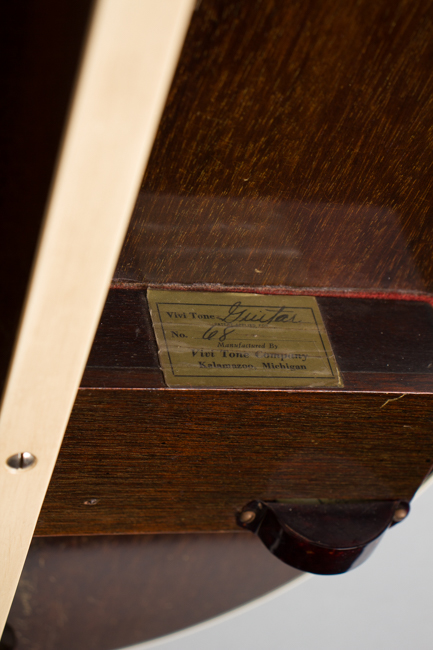Vivi-Tone Solid Body Electric Guitar (1932)
Vivi-Tone Solid Body Electric Guitar (1932), made in Kalamazoo, Michigan, serial # 68, dark mahogany finish, Mahogany centerpiece, maple body cap; laminated mahogany neck with ebony fingerboard., brown hard shell case.
This is a genuine museum piece, one of the rarest and most historically interesting guitars ever made. Designed by ex-Gibson "Master" Lloyd Loar and partner (at Gibson and beyond) Lewis A. Williams, this Vivi-Tone Electric represents THE earliest iteration of a true solid body electric guitar. Research indicates this solid "plank" body Vivi-Tone, built around mid-1932 is the first commercial attempt at a "standard" guitar specifically designed to have no resonant chamber at all. Although extremely short-lived and sold in minimal quantity, this is a well thought out and beautifully made instrument and a truly unique piece of history.
Williams and Loar left Gibson in 1923 and '24, respectively. By the early 1930s Williams was bullish on the future of amplification, and by 1932 Loar joined him in launching the all-electric Vivi-Tone company. They were predated only by the lost 1929 Stromberg-Voisinet electrics, and contemporary the earliest 1932 Rickenbacker Electro models. Loar himself primarily played violin and mandolin family instruments; Vivi-Tone's extensive early line comprised bowed and plucked string instruments as well as electric keyboards. Loar's stated goal was to capture "pure string tone" thus these designs eliminated the "interfering" resonance of an acoustic body. These "skeleton" instruments were the first Vivi-Tone products, promoted in a brochure issued by August 1932.
The few existing guitars from this early period each have unique features; this one has many detail differences from #47 which we have also examined. It has serial #68 hand-written on the label; that series would include all types of instrument, only a small proportion being guitars. Despite its eccentric design, this is a beautifully made and very playable guitar with a complex, if somewhat primitive, pickup design. The solid "body" consists of a 19" long 2 1/4" deep piece of mahogany, to which the neck is attached. This core is tapered back to front mirroring the neck heel and capped on the back in ivoroid. The back end mounts the tailpiece and has a curved veneer on each side to widen it a bit. The guitar "body" is a flat plate of mahogany only 1/8" thick, triple bound on the edges and decorated with painted f-holes. The finish overall is a dark mahogany reminiscent of period Gibson finishes.
The neck is laminated mahogany with an ivoroid center strip shaped to rounded profile with just the hint of a "V". The bound rosewood fingerboard has pearl dot inlay. The headstock is veneered front and back with ivoroid, with an unusual screened Art Nouveau Vivi-Tone logo on the face that is different from others we have seen. The tuners are Waverly strips with engraved baseplates and grained ivoroid buttons. The original tailpiece is NOT the familiar cast manganese with an impressed Vivi-Tone logo, but a generic stamped metal piece more familiar from period budget flat tops. This exact same piece is seen on the unique thin-body Vivi-Tone #97 made for Alvino Ray; the company may simply have run short of the "correct" unit! The bridge is a carved piece of maple (stained dark) with an ebony cap. This mounts through a black-edged slot in the body to rest on the pickup apparatus underneath. The instrument is quite elegant in appearance, from the front anyway!
The pickup is enclosed in a wooden box under the bridge which also carries the lever-activated volume control and unusual thin-plug terminal connectors. Loar's pickup design is a hybrid magnetic/electrostatic type with vibration from the wooden bridge activating a metal plate sensed by the magnetic coil beneath. This is not as effective as the horseshoe magnet design pioneered by Rickenbacker at the same time, but is fully functional. This guitar has the most impressive output of any Vivi-Tone we have heard.
According to the latest research this guitar was built at the latest in the summer of 1932. By that fall Vivi-Tone abandoned this design, re-thinking their guitars into more familiar (but still rare) Acoustic-electric instruments launched in 1933. In the thin depression years the company never prospered, with no more than 6-700 total instruments of all styles produced into the later 30s. No more than 96 total Vivi-tone instruments of all types of this "plank" design would have been produced, with only a small proportion being guitars.
Today just a handful of these "Skeleton" Vivi-Tone guitars are documented to exist. In 1932 Hawaiian guitars were the primary focus at Rickenbacker, and their few earliest Standard models were built with a hollow body. This Vivi-Tone guitar stands as the earliest commercially produced solid body guitar, the very beginnings of where the guitar would go over the next century. This historic piece remains in amazingly fine original condition, and plays and sounds better than any we have ever encountered.
Overall length is 37 7/8 in. (96.2 cm.), 13 7/16 in. (34.1 cm.) wide at lower bout, and 2 7/16 in. (6.2 cm.) in depth at deepest point. Scale length is 24 1/4 in. (616 mm.).
This 91-year-old guitar is an amazing survivor, fully original and in excellent playable condition. The finish shows a lot of fine checking on the "plank" body and minor wear overall with some small dings, dents and scrapes. Some of the ivoroid components have shrunk up slightly over time but there is no noticeable deterioration.
The neck is quite straight, the frets have minimal wear and the guitar plays nicely. The sound is of course somewhat microphonic, put has a much stronger output than some Vivi-Tones we have had (and we've had more than most!) and can be quite pleasing even considering the limitations. There is period cord in the case, with a newer custom-made one provided that allows better connection from the eccentric micro-plug terminals on the guitar to any amp input.
A commercial non-starter when new, this amazingly unique instrument now represents the earliest beginnings of the amplified guitar, THE very first style of solid body electric. It is genuine museum piece worthy of any collection of 20th century instruments, and a testament to the futuristic genius of Lloyd Loar and Lewis Williams. Overall Excellent Condition.
This is a genuine museum piece, one of the rarest and most historically interesting guitars ever made. Designed by ex-Gibson "Master" Lloyd Loar and partner (at Gibson and beyond) Lewis A. Williams, this Vivi-Tone Electric represents THE earliest iteration of a true solid body electric guitar. Research indicates this solid "plank" body Vivi-Tone, built around mid-1932 is the first commercial attempt at a "standard" guitar specifically designed to have no resonant chamber at all. Although extremely short-lived and sold in minimal quantity, this is a well thought out and beautifully made instrument and a truly unique piece of history.
Williams and Loar left Gibson in 1923 and '24, respectively. By the early 1930s Williams was bullish on the future of amplification, and by 1932 Loar joined him in launching the all-electric Vivi-Tone company. They were predated only by the lost 1929 Stromberg-Voisinet electrics, and contemporary the earliest 1932 Rickenbacker Electro models. Loar himself primarily played violin and mandolin family instruments; Vivi-Tone's extensive early line comprised bowed and plucked string instruments as well as electric keyboards. Loar's stated goal was to capture "pure string tone" thus these designs eliminated the "interfering" resonance of an acoustic body. These "skeleton" instruments were the first Vivi-Tone products, promoted in a brochure issued by August 1932.
The few existing guitars from this early period each have unique features; this one has many detail differences from #47 which we have also examined. It has serial #68 hand-written on the label; that series would include all types of instrument, only a small proportion being guitars. Despite its eccentric design, this is a beautifully made and very playable guitar with a complex, if somewhat primitive, pickup design. The solid "body" consists of a 19" long 2 1/4" deep piece of mahogany, to which the neck is attached. This core is tapered back to front mirroring the neck heel and capped on the back in ivoroid. The back end mounts the tailpiece and has a curved veneer on each side to widen it a bit. The guitar "body" is a flat plate of mahogany only 1/8" thick, triple bound on the edges and decorated with painted f-holes. The finish overall is a dark mahogany reminiscent of period Gibson finishes.
The neck is laminated mahogany with an ivoroid center strip shaped to rounded profile with just the hint of a "V". The bound rosewood fingerboard has pearl dot inlay. The headstock is veneered front and back with ivoroid, with an unusual screened Art Nouveau Vivi-Tone logo on the face that is different from others we have seen. The tuners are Waverly strips with engraved baseplates and grained ivoroid buttons. The original tailpiece is NOT the familiar cast manganese with an impressed Vivi-Tone logo, but a generic stamped metal piece more familiar from period budget flat tops. This exact same piece is seen on the unique thin-body Vivi-Tone #97 made for Alvino Ray; the company may simply have run short of the "correct" unit! The bridge is a carved piece of maple (stained dark) with an ebony cap. This mounts through a black-edged slot in the body to rest on the pickup apparatus underneath. The instrument is quite elegant in appearance, from the front anyway!
The pickup is enclosed in a wooden box under the bridge which also carries the lever-activated volume control and unusual thin-plug terminal connectors. Loar's pickup design is a hybrid magnetic/electrostatic type with vibration from the wooden bridge activating a metal plate sensed by the magnetic coil beneath. This is not as effective as the horseshoe magnet design pioneered by Rickenbacker at the same time, but is fully functional. This guitar has the most impressive output of any Vivi-Tone we have heard.
According to the latest research this guitar was built at the latest in the summer of 1932. By that fall Vivi-Tone abandoned this design, re-thinking their guitars into more familiar (but still rare) Acoustic-electric instruments launched in 1933. In the thin depression years the company never prospered, with no more than 6-700 total instruments of all styles produced into the later 30s. No more than 96 total Vivi-tone instruments of all types of this "plank" design would have been produced, with only a small proportion being guitars.
Today just a handful of these "Skeleton" Vivi-Tone guitars are documented to exist. In 1932 Hawaiian guitars were the primary focus at Rickenbacker, and their few earliest Standard models were built with a hollow body. This Vivi-Tone guitar stands as the earliest commercially produced solid body guitar, the very beginnings of where the guitar would go over the next century. This historic piece remains in amazingly fine original condition, and plays and sounds better than any we have ever encountered.
Overall length is 37 7/8 in. (96.2 cm.), 13 7/16 in. (34.1 cm.) wide at lower bout, and 2 7/16 in. (6.2 cm.) in depth at deepest point. Scale length is 24 1/4 in. (616 mm.).
This 91-year-old guitar is an amazing survivor, fully original and in excellent playable condition. The finish shows a lot of fine checking on the "plank" body and minor wear overall with some small dings, dents and scrapes. Some of the ivoroid components have shrunk up slightly over time but there is no noticeable deterioration.
The neck is quite straight, the frets have minimal wear and the guitar plays nicely. The sound is of course somewhat microphonic, put has a much stronger output than some Vivi-Tones we have had (and we've had more than most!) and can be quite pleasing even considering the limitations. There is period cord in the case, with a newer custom-made one provided that allows better connection from the eccentric micro-plug terminals on the guitar to any amp input.
A commercial non-starter when new, this amazingly unique instrument now represents the earliest beginnings of the amplified guitar, THE very first style of solid body electric. It is genuine museum piece worthy of any collection of 20th century instruments, and a testament to the futuristic genius of Lloyd Loar and Lewis Williams. Overall Excellent Condition.
